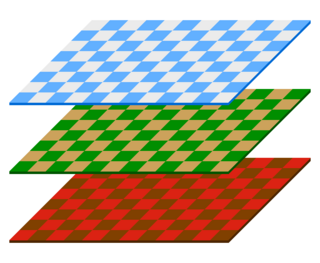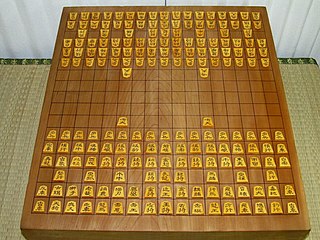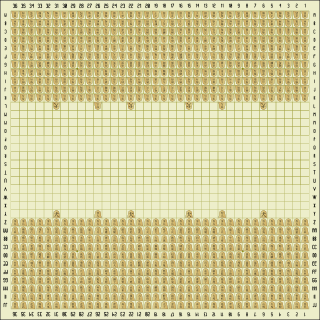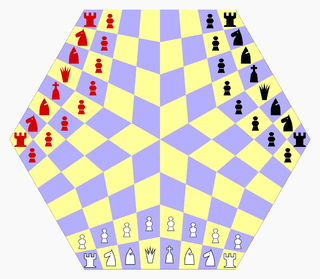
Chaturanga is an ancient Indian strategy board game. It is first known from India around the seventh century CE, but its roots may date 5000 years back, to the Indus Valley Civilization.
A fairy chess piece, variant chess piece, unorthodox chess piece, or heterodox chess piece is a chess piece not used in conventional chess but incorporated into certain chess variants and some chess problems. Compared to conventional pieces, fairy pieces vary mostly in the way they move, but they may also follow special rules for capturing, promotions, etc. Because of the distributed and uncoordinated nature of unorthodox chess development, the same piece can have different names, and different pieces can have the same name in various contexts as it can be noted in the list of fairy chess pieces.

Dragonchess is a three-dimensional fantasy chess variant created by Gary Gygax, co-creator of the famed role-playing game Dungeons & Dragons. The game was introduced in 1985 in issue No. 100 of Dragon Magazine.

Dai dai shōgi is a large board variant of shogi. The game dates back to the 15th century and is based on the earlier dai shogi. Apart from its size, the major difference is in the range of the pieces and the "promotion by capture" rule. It is the smallest board variant to use this rule.

Taikyoku shōgi is the largest known variant of shogi. The game was created around the mid-16th century and is based on earlier large board shogi games. Before the rediscovery of taikyoku shogi in 1997, tai shogi was believed to be the largest physically playable chess variant ever. It has not been shown that taikyoku shogi was ever widely played. There are only two sets of restored taikyoku shogi pieces and one of them is held at Osaka University of Commerce. One game may be played over several long sessions and require each player to make over a thousand moves.

Hexagonal chess is a group of chess variants played on boards composed of hexagon cells. The best known is Gliński's variant, played on a symmetric 91-cell hexagonal board.
Legan chess is a chess variant invented by L. Legan in 1913. It differs from standard chess by the starting position as well as by pawn movements.
Courier chess is a chess variant that dates from the 12th century and was popular for at least 600 years. It was a part of the slow evolution towards modern chess from Medieval Chess.

Rhombic chess is a chess variant for two players created by Tony Paletta in 1980. The gameboard has an overall hexagonal shape and comprises 72 rhombi in three alternating colors. Each player commands a full set of standard chess pieces.

Triangular chess is a chess variant for two players invented by George R. Dekle Sr. in 1986. The game is played on a hexagon-shaped gameboard comprising 96 triangular cells. Each player commands a full set of chess pieces in addition to three extra pawns and a unicorn.
EuroShogi is a shogi variant invented by Vladimír Pribylinec starting in 2000. The game developed from an early version of chess variant Echos in 1977, leading to Cubic Chess, then later to Cubic Shogi, and finally to EuroShogi. Instead of the classic figures, 18 black and 18 white cubes are used, which are on two opposing sides without symbols. The other two cubes on the opposite sides have one white and one black symbol. The other opposing sides are the same symbols of the opposite color - their promotion is indicated by a circle around symbol. Symbol on top of its mobility. The pieces are placed on the board so that they are oriented towards players without any symbolic surfaces. Plays on a board with 8x8 fields of the same color.

Masonic chess is a chess variant invented by George R. Dekle Sr. in 1983. The game is played on a modified chessboard whereby even-numbered ranks are indented to the right—resembling masonry brickwork. The moves of the pieces are adapted to the new geometry; in other respects the game is the same as chess.

Chesquerque is a chess variant invented by George R. Dekle Sr. in 1986. The game is played on a board composed of four Alquerque boards combined into a square. Like Alquerque, pieces are positioned on points of intersection and make their moves along marked lines ; as such, the board comprises a 9×9 grid with 81 positions (points) that pieces can move to.

Tri-chess is the name of a chess variant for three players invented by George R. Dekle Sr. in 1986. The game is played on a board comprising 150 triangular cells. The standard chess pieces are present, minus the queens, and plus the chancellor and cardinal compound fairy pieces per side.

Three-man chess is a chess variant for three players invented by George R. Dekle Sr. in 1984. The game is played on a hexagonal board comprising 96 quadrilateral cells. Each player controls a standard army of chess pieces.

Quatrochess is a chess variant for four players invented by George R. Dekle Sr. in 1986. It is played on a square 14×14 board that excludes the four central squares. Each player controls a standard set of sixteen chess pieces, and additionally nine fairy pieces. The game can be played in partnership or all-versus-all.

Falcon–hunter chess is a chess variant invented by Karl Schultz in 1943, employing the two fairy chess pieces falcon and hunter. The game takes several forms, including variations hunter chess and decimal falcon–hunter chess added in the 1950s.

Congo is a chess variant invented by Demian Freeling in 1982 when he was nearly 8 years old. His father encouraged him to design a variant using a 7×7 gameboard. Demian was already familiar with chess and xiangqi, and the result blends some features from both. Congo became the second-most popular chess variant at the Fanaat games club in Enschede, the Netherlands.
Grant Acedrex is a medieval chess variant dating back to the time of King Alfonso X of Castile. It appears in the Libro de los Juegos of 1283.
Spherical chess is any of several chess variants played on boards composed of fields arranged on the surface of a sphere.




















